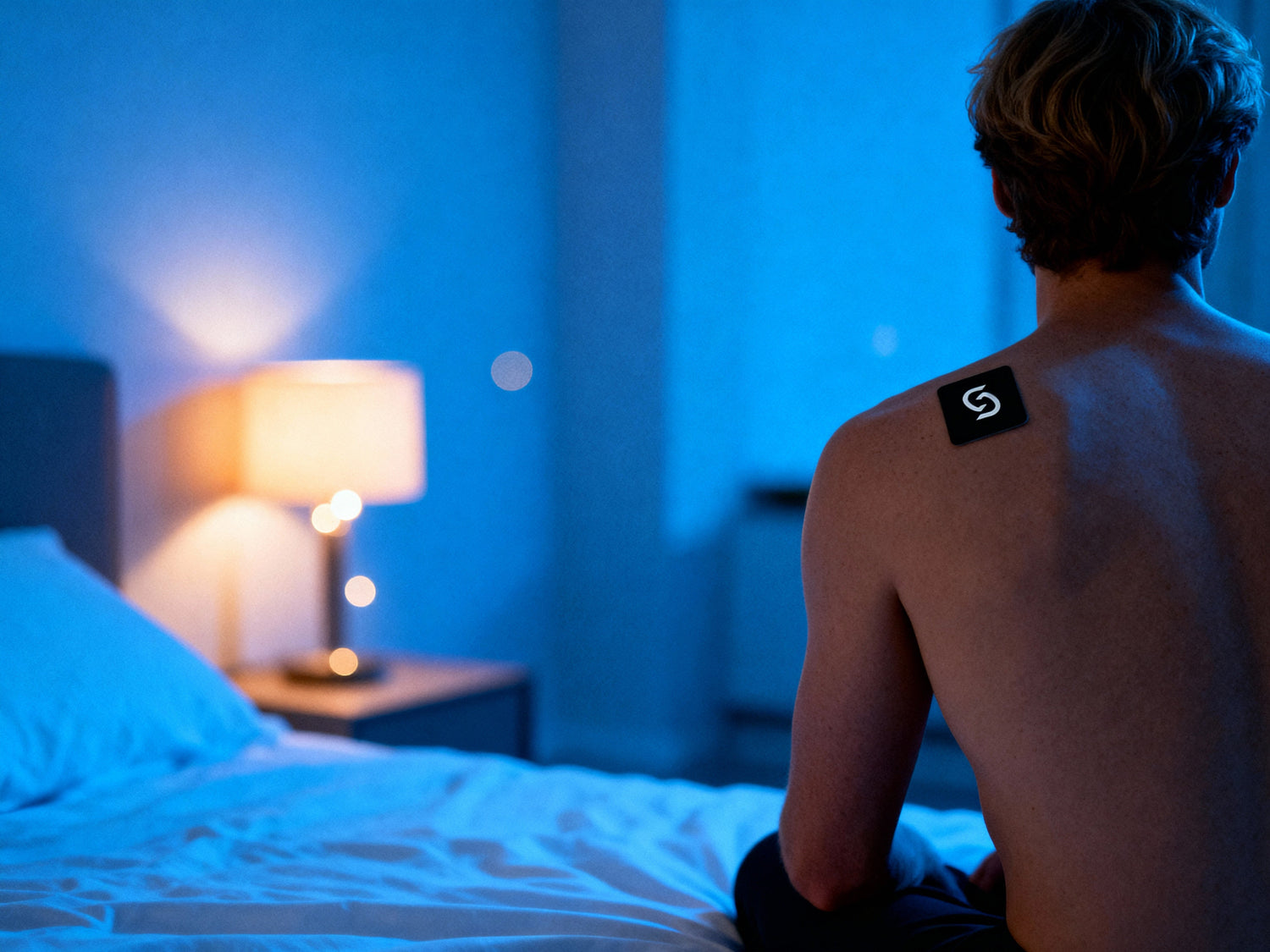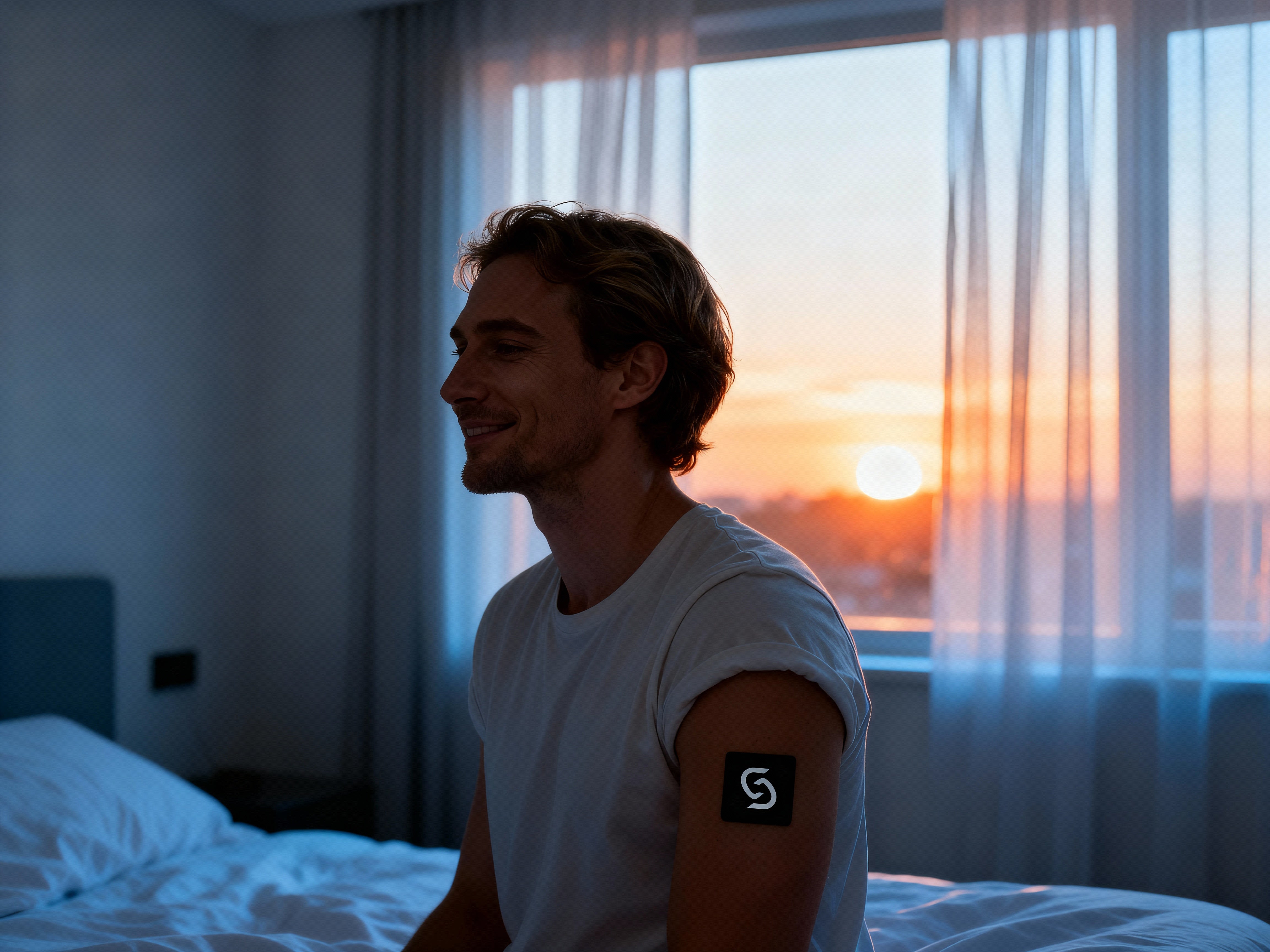What SLEEP+ is built to do
- Shorten sleep onset (~30–45 min typical onset).
- Stabilize deep sleep for ~8–10 h via a gentle, steady curve.
- Support a clear morning wake-up with minimal grogginess.
Transdermal micro-diffusion delivers a gradual rise → plateau → taper, avoiding the spike-and-crash you can get with some pills or liquids.
What’s inside—and why it works
| Ingredient | Role | Why transdermal helps |
|---|---|---|
| Melatonin (3 mg) | Sleep-onset signal; nudges circadian timing | Bypasses digestion, steadier surface exposure |
| L-Theanine (100 mg) | Calms mental chatter without sedation | Smooths edges for a quieter mind |
| Magnesium (60 mg elemental as citrate) | Muscle relaxation, sleep quality | Gentle support over hours |
| Valerian 5:1 (80 mg) | Traditional aid for sleep latency | Complementary, non-heavy |
| Passionflower (80 mg) | Soothes busy thoughts | Helps reduce midnight restlessness |
| Chamomile (Apigenin 2 mg) | Promotes relaxation | Low-dose precision |
| Lavender EO (1 mg) | Calming sensory cue | Subtle aromatics near skin |
EU-friendly: no 5-HTP, no tryptophan.
Note: Sweat-resistant for workouts; not waterproof—avoid showering/swimming while wearing.
Timing, placement, and wear time (the 90% of success)
When: apply 30–60 minutes before bed.
Where (rotate daily):
- Upper shoulder/deltoid
- Shoulder blade / upper back
- Hip / side of torso
- Outer upper arm
How: clean, dry skin → peel → stick → press 10–15 s.
Wear time: ~8–10 h. If you wake groggy, reduce by 30–60 min the next night.
Your first 7 nights with SLEEP+
Nights 1–2 — Find your onset window
- Apply 45–60 min before lights out.
- Keep bedtime habits constant (dim lights, no heavy meals <2 h).
- Log: “time to feel drowsy,” “time lights off,” “wake quality.”
Nights 3–4 — Lock the curve
- Move to 30–45 min if drowsy came too early; stay at 45–60 if it was perfect.
- Aim for 8–9 h wear time; adjust by ±30 min based on morning feel.
Nights 5–7 — Optimize depth & wake-up
- If you still wake at ~3 a.m., place the patch on a thicker site (upper back/hip) or shift application 10–15 min later.
- If mornings feel heavy, reduce total wear (e.g., 7.5–8 h) and brighten your room on wake.
Tip: Morning daylight (2–10 min) plus 150–500 ml water after removing the patch speeds the “clear wake-up” signal.
Common scenarios & fixes
- “I wake around 3 a.m.”
- Keep bedtime consistent (±30 min).
- Try upper back/hip placement; it often yields a smoother overnight curve.
- Move application 10–15 min later so the plateau extends deeper into the night.
- Reduce alcohol; it fragments deep sleep.
- “I fall asleep, but wake groggy.”
- Shorten wear time by 30–60 min (e.g., 9 h → 8–8.5 h).
- Add bright light on wake and movement in the first 10–20 min.
- Avoid snooze cycles; one decisive wake protects alertness.
- “Busy mind won’t shut off.”
- Keep SLEEP+ at 45–60 min pre-bed.
- Add a 3-minute brain dump (paper), then a 1–2 min exhale-focused breathing (e.g., 4-sec inhale / 6-sec exhale).
- Consider earlier caffeine cutoff (≥8 h before bed).
Exact routine (copy–paste)
- T-60 to T-45: dim lights; last screen check.
- T-45 to T-30: apply SLEEP+; quick shower before applying; light snack only if needed.
- T-30 to T-10: winding down (reading, stretching, low conversation).
- T-10: in bed; lights very low.
- T-0: lights out; room cool (17–19 °C), dark, quiet.
- Morning: remove patch; daylight, water, brief movement.
Transdermal vs. oral: why a patch at night?
- Bypasses digestion → fewer GI variables and late-night reflux risk.
- Sustained micro-diffusion → smoother 8–10 h support through the full sleep architecture.
- Predictable timing → you control onset window by when you apply, not when a capsule dissolves.
Safety & good practice
- Educational information only—not medical advice. If pregnant, nursing, on medication, or with a medical condition, consult a healthcare professional. Discontinue if skin irritation persists; rotate placement; do not layer multiple patches on the same site. Not waterproof.
Quick FAQ
-
How long until I feel drowsy?
Typical onset 30–45 min after application. -
Can I work out in the evening with the patch on?
Yes, it’s sweat-resistant. Shower before, not after; avoid swimming. -
What if my schedule shifts (travel, jet lag)?
Apply SLEEP+ at the new local bedtime for 3–4 nights to help anchor the rhythm. Use FOCUS+ soon after local wake to reinforce daytime alertness. -
Is SLEEP+ habit-forming?
No; it’s a non-sedative blend designed for transdermal micro-diffusion and steady support. -
Do I need to cycle off?
Not required for most users. Keep rotating skin sites and tune wear time.


Leave a comment
All comments are moderated before being published.
This site is protected by hCaptcha and the hCaptcha Privacy Policy and Terms of Service apply.